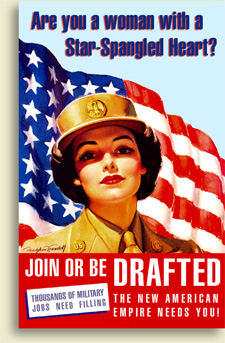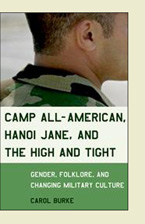Drafting
Women: Carol Burke, Camp All-American
"Women
are citizens of the United States and have a responsibility that
goes along with that citizenry to protect and defend the United States
if there is a universal draft,” says Carol Burke.
 An
associate professor of English and comparative literature at the
University of California at Irvine and a folklorist
who taught as a civilian professor at the Naval Academy in Annapolis,
Maryland, for seven years, Burke believes that
any military draft plan that doesn't include women will face a
sex discrimination challenge in court. An
associate professor of English and comparative literature at the
University of California at Irvine and a folklorist
who taught as a civilian professor at the Naval Academy in Annapolis,
Maryland, for seven years, Burke believes that
any military draft plan that doesn't include women will face a
sex discrimination challenge in court.
“I
think that it’s inevitable that women will assume positions
in the military next to men, doing what men do,” Burke says. “It’s
only a matter of time.”
Burke's
eye-opening new book, Camp
All-American, Hanoi Jane, and the High and Tight, leaves
no doubt that the armed forces should jettison its cult of masculinity.
The book details misogyny in the modern military — from
homoerotic hazing and secret rituals of military manhood to Tailhook
and Napalm chants.
"See
the woman beside the river,
Washin' clothes and cookin' dinner,
Pick one out and watch her quiver,
Yo, oh! Napalm it sticks to kids."
That's
the kind of brutal folklore you'll encounter in Camp
All-American — a book that separates the macho from
the military.
Many
people “view the military as an institution, that in part exists
to inscribe manhood on its members,” says Burke. “Whereas
that may be productive if you have an all male military, it’s
not productive when you have a gender-integrated military.”
What
about the claim by military traditionalists — Orange County,
California's ex-Congressman Bob
Dornan, for example — that woman aren't physically capable
of serving in combat?
“A
strong athletic, six-foot-tall woman will outperform a slim, five-foot-tall
man who lacks substantially developed muscle mass,’ Burke says. “In
some areas of combat, the smaller size and greater agility of women
would be an advantage. Inside a tank or a submarine, for example,
a small quick female soldier might be more effective than a thickly-muscled
linebacker-sized man.”
In
spite of gender advantages, a ramped-up leveling of the military's
man to woman ratio won't happen until after the November election.
It's simply too hot of a political issue for the tepid Kerry and
Bush campaigns. After November, however, it may be time for the Kiera
Knightly demographic to start registering at Selective
Service. Two bills in Congress (S 89 and HR 163) call for inclusion
of 18-26 year-old women in a 500,000 troop draft that would began
as early as Spring 2005.
 “When
you look at skeptical leaders who have then had women under their
command, you find a real change in their support in terms of women
being involved,” Burke says. “In many ways there is more
willingness to integrate women on the part of the Pentagon, then
there is in conservative civilian groups." “When
you look at skeptical leaders who have then had women under their
command, you find a real change in their support in terms of women
being involved,” Burke says. “In many ways there is more
willingness to integrate women on the part of the Pentagon, then
there is in conservative civilian groups."
So
why hasn't this integration happened sooner?
"Full
integration has been retarded by the current administration’s
responsiveness to conservative critics from the outside. There are
a number of civilians groups that are fighting the integration of
women in the military — the Center
for Military Readiness [CMR] for example.”
Not
only fighting it, but spinning a devolutionary frame on it. In an
April 2003 report entitled “Why
American Servicewomen are Serving at Greater Risk,” CMR
stated, “In a nation and culture that respects women, close
combat on an equal basis with men is not a step forward for women,
it is a step backward for civilization.”
That
step backward becomes a leap forward, however, as you move away
from the conservative end of the political spectrum. Susan Scanlan
President of the non-partisan Women's
Research & Education Institute in Washington DC stands
with Burke on the issue of female conscription.
“Women
should be drafted if men are because both men and women are citizens
who are obligated to serve their country,” Scanlan says. “There
are plenty of jobs military women can do. Traditionally, draftees
have gone into the Army infantry (which includes combat positions
from which women are excluded), but there is no reason they couldn’t
be assigned to other slots in the Army or to the Navy, Air Force,
Marine, and Coast Guard. Certainly the women serving today provide
strong proof that they are more than capable of doing their jobs
under extremely challenging circumstances.”
Those
circumstances became even more challenging on June 1, 2004. That's
when the Army
announced that thousands active-duty and reserve soldiers who
are nearing the end of their volunteer service commitments in the
Middle East could be forced to serve an entire tour overseas. Democratic
presidential candidate John Kerry called the extension a "backdoor
draft."
Burke
tells me that before this recent extension the armed forces would
have argued in favor of an all-volunteer force. “Current members
of the military want to fight side by side with well-trained volunteers.
But, there are political calculations to be made," she says. "Massive
conscription to keep the shaky peace in Iraq, whether the nation
pulls men only or men and women into service, would doom any administration
that orchestrates it.”
Why?
Massive
conscription would
inspire a higher voter turnout among 18-25 year olds, especially
among women. In a CNN
Poll conducted in October 2003, 88 percent of Americans under
30 years of age disapproved of a draft. Today, with the ugly reality
of the War in Iraq creating more than just Rumsfeld-style guts and
glory headlines, those numbers may be higher.
The National
Organization for Women (NOW) agrees with the under 30 crowd.
According to NOW's press secretary Jenny Thalheimer, that organization's
official policy “Opposes the reinstatement of registration
and draft for both men and women. However, if we cannot stop the
return to registration and draft," the policy goes on to say, "we
also cannot choose between our sisters and brothers. We oppose
any registration or draft that excludes women as an unconstitutional
denial of rights to both young men and women. And we continue to
oppose all sex discrimination by the volunteer armed services.”
With
sex discrimination out front, a test case coupled with the ACLU
could push the issue of women in the draft to the Supreme Court.
“I
presume that there would be a legal challenge to any male-only draft,” Burke
says. “Since women in uniform have proven themselves so capable
in military roles traditionally reserved for men, it would be hard
to argue for their exclusion simply on the basis of gender.”
True.
But is the War in Iraq the best test case for inclusion? Will drafted
women consider themselves the winners? And what of the cult of masculinity's
folklore? Will women chant:
"Aim
your missiles at the schoolhouse,
See the teacher ring the bell.
See the children's smiling faces
As their schoolhouse burns to hell?"
As
Abu Ghraib has shown us and Barbara Ehrenreich has told us, a
uterus is not a substitute for a conscience. A responsibility
to protect and defend the United States includes protesting and
defying our government when it imposes a corrupt American hegemony
on the rest of world. Now is the time to ask, will the fight for
women's rights by way of a gender-integrated military draft contribute
to a universal wrong?
"I
think support for the current war in Iraq and support for a draft
that includes women are two very different things," Burke says. "I
never supported the former; nor do I favor any draft in support of
it. When our government sent troops to Iraq we expected to see photos
of caches of weapons of mass destruction. Instead, we've gotten photos
of the shameful acts of American soldiers. Were our country to face
a third world war (as opposed to the vaguely defined "war on
terrorism," a term that the Bush administration has employed
to justify a series of bad decisions including the decision to sidestep
the Geneva Convention) and need to deploy large numbers of young
Americans, women as well as men should do their part."
— Nathan Callahan,
June 9, 2004
|